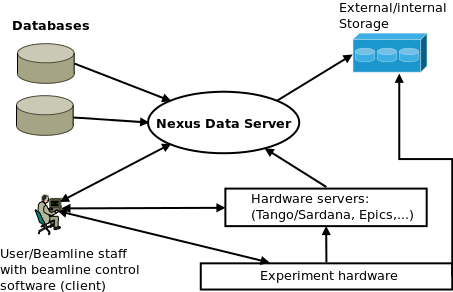Project goals¶
The aim of this project is to implement a Tango server that manages data IO for synchrotron (and maybe neutron) beamlines. The server should satisfy the following requirements
remove responsibility for data IO from the beamline control client
provide a simple configuration mechanism via NXDL
read data from the following sources without client interaction
SQL databases (MySQL, Postgres, Oracle, DB2, …)
other TANGO servers
JSON records (important for the interaction with the client and SARDANA)
the first implementation of the server will be written in Python
the communication model of the first implementation will be strictly synchronous (future version most probably will support other communication models too)
the control client software has full control over the behavior of the server via TANGO commands
only low data-rate sources will be handled directly by the server. High data-rate sources will write their data independently and additional software will add this data to the Nexus file produced by the server once the experiment is finished.
The server should make it easy to implement control clients which write Nexus files as the entire Nexus logic is kept in the server. Clients only produce NXDL configurations or use third party tools for this job. The first Python implementation of this server will serve as a proof of concept.
The importance of the client¶

All operations carried out on a beamline are orchestrated by the control client (CC), a software operated by the beamline-scientist and/or a user. Although the term client suggests that it is only a minor component aside from all the hardware control servers, databases, and whatever software is running on a beamline it is responsible for all the other components and tells them what to do at which point in time. In terms of an orchestra the CC is the director which tells each group of instruments or individual artist what to do at a certain point in time.
It is important to understand the role of the CC in the entire software system on a beamline as it determines who is responsible for certain operations. The CC might be a simple single script running on the control PC which can is configured by the user before start or it might be a whole application of its own like SPEC or ONLINE. Historically it is the job of the CC to write the data recorded during the experiment (this is true at least for low rate data-sources). However, with the appearance of complex data formats like Nexus the IO code becomes more complex.